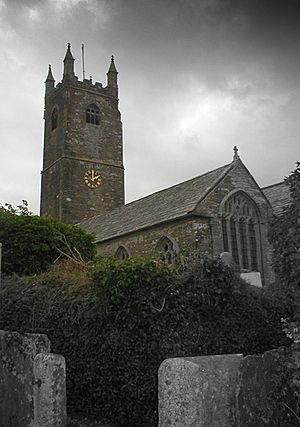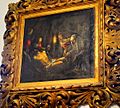St Mabyn Parish Church facts for kids
Quick facts for kids St Mabyn Parish Church |
|
|---|---|

St. Mabyn Parish Church, St.Mabyn
|
|
| 50°31′32″N 4°45′50″W / 50.52556°N 4.76389°W | |
| OS grid reference | SX 042 732 |
| Denomination | Church of England |
| Website | St Mabyn Church website |
| History | |
| Dedication | Mabyn |
| Administration | |
| Parish | St Mabyn, Cornwall |
| Deanery | Trigg Minor |
| Archdeaconry | Bodmin |
| Diocese | Truro |
| Province | Canterbury |
St Mabyn Church is a very old church in Cornwall, England. It was built a long time ago, in the late 1400s and early 1500s. This church is a special place of worship for the Church of England. It is named after Mabyn or Mabena, who was believed to be one of the many children of a Welsh saint named Brychan from the 400s. The church is so important that it is a Grade I listed building.
Contents
History of St Mabyn Church
The church you see today replaced an even older church. That first church was also named after Saint Mabyn. We know it was there a long time ago because it's mentioned in a book from the 1100s.
Scientists studied the wood in the church to find out when it was built. They found that different parts were constructed between the late 1400s and early 1500s. For example, the north side was built around 1513-1535. The main part of the church, called the nave, was built between 1485 and 1514. The entrance porch was built from 1487 to 1523.
The church was built in a style called Perpendicular, which was popular for churches back then. Some parts might even be from the older Norman style.
What Does the Church Look Like?
The church is made of ashlar slate stone. This means the stones are carefully cut and shaped. The roof is made of rag slate, which is a type of stone tile.
Inside, the church has a main area called the nave. It also has a chancel, which is where the altar is, and aisles on the north and south sides. The arches inside are made of granite. They are supported by tall, solid granite pillars. These pillars have special carved tops.
The church has a tall tower that is 85 feet high. It has three levels and a decorative top with battlements. There are also carved figures on the top level, which might be the Four Evangelists.
Inside the Church
You can find a piscina on the north side of the church. This is a small stone basin used to clean sacred vessels after church services. There are also remains of stairs that once led to a rood loft. A rood loft was a high platform above the main part of the church.
In the south aisle, there is another piscina and a special doorway for the priest. The font, which is used for baptisms, is very old. It has a round basin on a decorated stone pillar.
There is also a special stone table called a credence table. This table might have been part of a tomb built to honor Saint Mabena.
Bells and Clock
In 1787, the church had five bells. Later, it had six bells. Today, the belfry has eight bells that can ring many different tunes. A church clock was added in 1950.
Important Events and People
The earliest priest recorded at St Mabyn Church was Roger de Worlegan in 1267. Charles Peters, who was the rector from 1726 to 1775, was known as a very smart scholar. He wrote an important book about the Book of Job in 1751.
The church records, called registers, go all the way back to the year 1562.
One of the stained glass windows in the church is a memorial. It remembers Francis John Hext, who passed away in 1803, and his wife Margaret, who passed away in 1794.
In 2008, the church roof was repaired. This big project cost £115,000 and was partly paid for by English Heritage.
In March 2014, some items were stolen from the church. These included a painting from the 1800s and an old policeman's truncheon from 1807.
The current Priest in charge is David Seymour, and the minister is David Pollard.
Gallery







